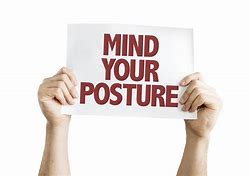
Strike a Pose for Good Posture!
Several factors can contribute to poor posture such as, stress, obesity, pregnancy, weak postural muscles and abnormally tight muscles. Decreased flexibility, a poor work environment, incorrect working posture, and unhealthy sitting and standing habits can also contribute to poor body positioning. People who wear high-heeled shoes also put themselves in unhealthy standing (and walking) positions.
To avoid the effects of poor posture it is important to understand the best body mechanics for sitting, standing and lying.
Sitting
· Keep your feet on the floor, if they don’t reach the floor, use a foot stool.
· Don’t cross your legs and make sure your ankles are in front of your knees.
· There should be a small gap between the back of your knees and the front of your seat.
· Your knees should be at or slightly below the level of your hips.
· The backrest of your chair must support your low- and mid-back, if it doesn’t, use a back support.
· Relax your shoulders and keep your forearms parallel to the ground.
· Avoid sitting in the same position for long periods of time.
Standing
· Bear your weight primarily on the balls of your feet.
· Bend your knees slightly.
· Your feet should be approximately shoulder-width apart.
· Relax your arms and let them hang naturally at your side.
· Keep your head level – your earlobes should be in line with your shoulders. Do not push your head forward, backward, or to the side.
· If you need to stand for long periods of time, shift your weight from your toes to your heels, or one foot to the other from time-to-time.
Lying
· Find a mattress that is right for you. While a firm mattress is generally recommended, some people prefer softer mattresses to relieve back pain. For a good night’s sleep, it is important that you are comfortable.
· Sleep with a pillow. If you have a postural problem, your health care provider may recommend a special pillow that will help with your specific problem.
· It is best to avoid sleeping on your stomach.
· Sleeping on your side or back is often best for relieving back pain. If you sleep on your side, place a pillow between your legs. If you sleep on your back, keep a pillow under your knees.
Thankfully, poor posture can be corrected. Being mindful of your posture and knowing how to correct your specific problems will help you make the necessary adjustments. If you have a serious posture concern a chiropractor will help alleviate your pain and assist you with proper posture by recommending exercises to strengthen your core postural muscles and help you use proper postures during your activities, which will help reduce your risk of injury.



